The Impact of Counterfeit Luxury Goods on Consumer Behavior
VerifiedAdded on 2020/11/12
|14
|4890
|247
AI Summary
The provided document is a comprehensive list of research articles related to the topic of counterfeit luxury goods. It includes 50 references from various journals and academic sources, covering aspects such as consumer intention to purchase counterfeit products, brand mimicry, and the impact on customer satisfaction. The assignment likely requires students to analyze these studies and discuss their findings in relation to a specific question or task.
Contribute Materials
Your contribution can guide someone’s learning journey. Share your
documents today.

DISSERTATION (LITERATURE
CHAPTER)
(Impact of counterfeit products on luxury brands research
proposal)
CHAPTER)
(Impact of counterfeit products on luxury brands research
proposal)
Secure Best Marks with AI Grader
Need help grading? Try our AI Grader for instant feedback on your assignments.
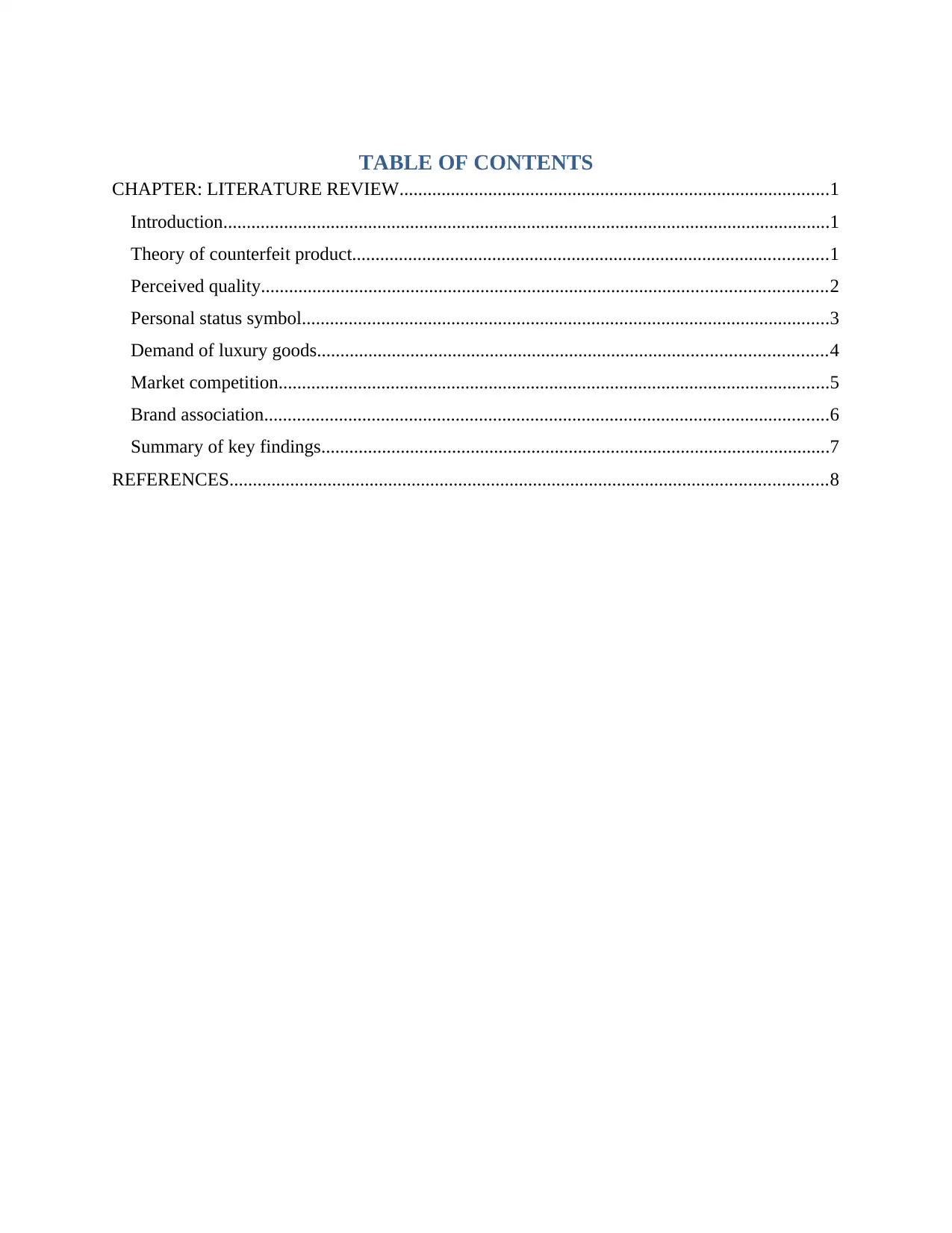
TABLE OF CONTENTS
CHAPTER: LITERATURE REVIEW............................................................................................1
Introduction..................................................................................................................................1
Theory of counterfeit product......................................................................................................1
Perceived quality.........................................................................................................................2
Personal status symbol.................................................................................................................3
Demand of luxury goods.............................................................................................................4
Market competition......................................................................................................................5
Brand association.........................................................................................................................6
Summary of key findings.............................................................................................................7
REFERENCES................................................................................................................................8
CHAPTER: LITERATURE REVIEW............................................................................................1
Introduction..................................................................................................................................1
Theory of counterfeit product......................................................................................................1
Perceived quality.........................................................................................................................2
Personal status symbol.................................................................................................................3
Demand of luxury goods.............................................................................................................4
Market competition......................................................................................................................5
Brand association.........................................................................................................................6
Summary of key findings.............................................................................................................7
REFERENCES................................................................................................................................8
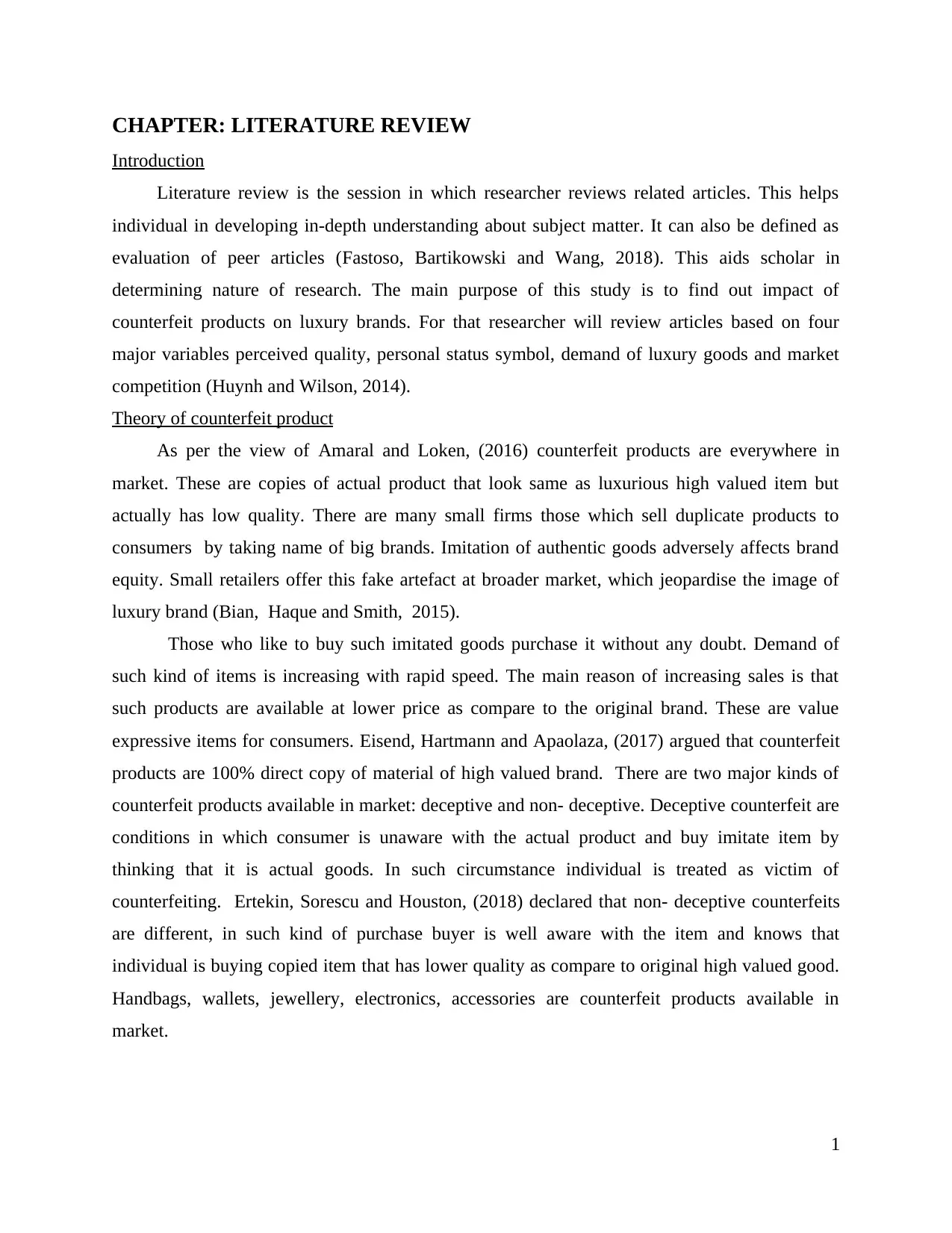
CHAPTER: LITERATURE REVIEW
Introduction
Literature review is the session in which researcher reviews related articles. This helps
individual in developing in-depth understanding about subject matter. It can also be defined as
evaluation of peer articles (Fastoso, Bartikowski and Wang, 2018). This aids scholar in
determining nature of research. The main purpose of this study is to find out impact of
counterfeit products on luxury brands. For that researcher will review articles based on four
major variables perceived quality, personal status symbol, demand of luxury goods and market
competition (Huynh and Wilson, 2014).
Theory of counterfeit product
As per the view of Amaral and Loken, (2016) counterfeit products are everywhere in
market. These are copies of actual product that look same as luxurious high valued item but
actually has low quality. There are many small firms those which sell duplicate products to
consumers by taking name of big brands. Imitation of authentic goods adversely affects brand
equity. Small retailers offer this fake artefact at broader market, which jeopardise the image of
luxury brand (Bian, Haque and Smith, 2015).
Those who like to buy such imitated goods purchase it without any doubt. Demand of
such kind of items is increasing with rapid speed. The main reason of increasing sales is that
such products are available at lower price as compare to the original brand. These are value
expressive items for consumers. Eisend, Hartmann and Apaolaza, (2017) argued that counterfeit
products are 100% direct copy of material of high valued brand. There are two major kinds of
counterfeit products available in market: deceptive and non- deceptive. Deceptive counterfeit are
conditions in which consumer is unaware with the actual product and buy imitate item by
thinking that it is actual goods. In such circumstance individual is treated as victim of
counterfeiting. Ertekin, Sorescu and Houston, (2018) declared that non- deceptive counterfeits
are different, in such kind of purchase buyer is well aware with the item and knows that
individual is buying copied item that has lower quality as compare to original high valued good.
Handbags, wallets, jewellery, electronics, accessories are counterfeit products available in
market.
1
Introduction
Literature review is the session in which researcher reviews related articles. This helps
individual in developing in-depth understanding about subject matter. It can also be defined as
evaluation of peer articles (Fastoso, Bartikowski and Wang, 2018). This aids scholar in
determining nature of research. The main purpose of this study is to find out impact of
counterfeit products on luxury brands. For that researcher will review articles based on four
major variables perceived quality, personal status symbol, demand of luxury goods and market
competition (Huynh and Wilson, 2014).
Theory of counterfeit product
As per the view of Amaral and Loken, (2016) counterfeit products are everywhere in
market. These are copies of actual product that look same as luxurious high valued item but
actually has low quality. There are many small firms those which sell duplicate products to
consumers by taking name of big brands. Imitation of authentic goods adversely affects brand
equity. Small retailers offer this fake artefact at broader market, which jeopardise the image of
luxury brand (Bian, Haque and Smith, 2015).
Those who like to buy such imitated goods purchase it without any doubt. Demand of
such kind of items is increasing with rapid speed. The main reason of increasing sales is that
such products are available at lower price as compare to the original brand. These are value
expressive items for consumers. Eisend, Hartmann and Apaolaza, (2017) argued that counterfeit
products are 100% direct copy of material of high valued brand. There are two major kinds of
counterfeit products available in market: deceptive and non- deceptive. Deceptive counterfeit are
conditions in which consumer is unaware with the actual product and buy imitate item by
thinking that it is actual goods. In such circumstance individual is treated as victim of
counterfeiting. Ertekin, Sorescu and Houston, (2018) declared that non- deceptive counterfeits
are different, in such kind of purchase buyer is well aware with the item and knows that
individual is buying copied item that has lower quality as compare to original high valued good.
Handbags, wallets, jewellery, electronics, accessories are counterfeit products available in
market.
1
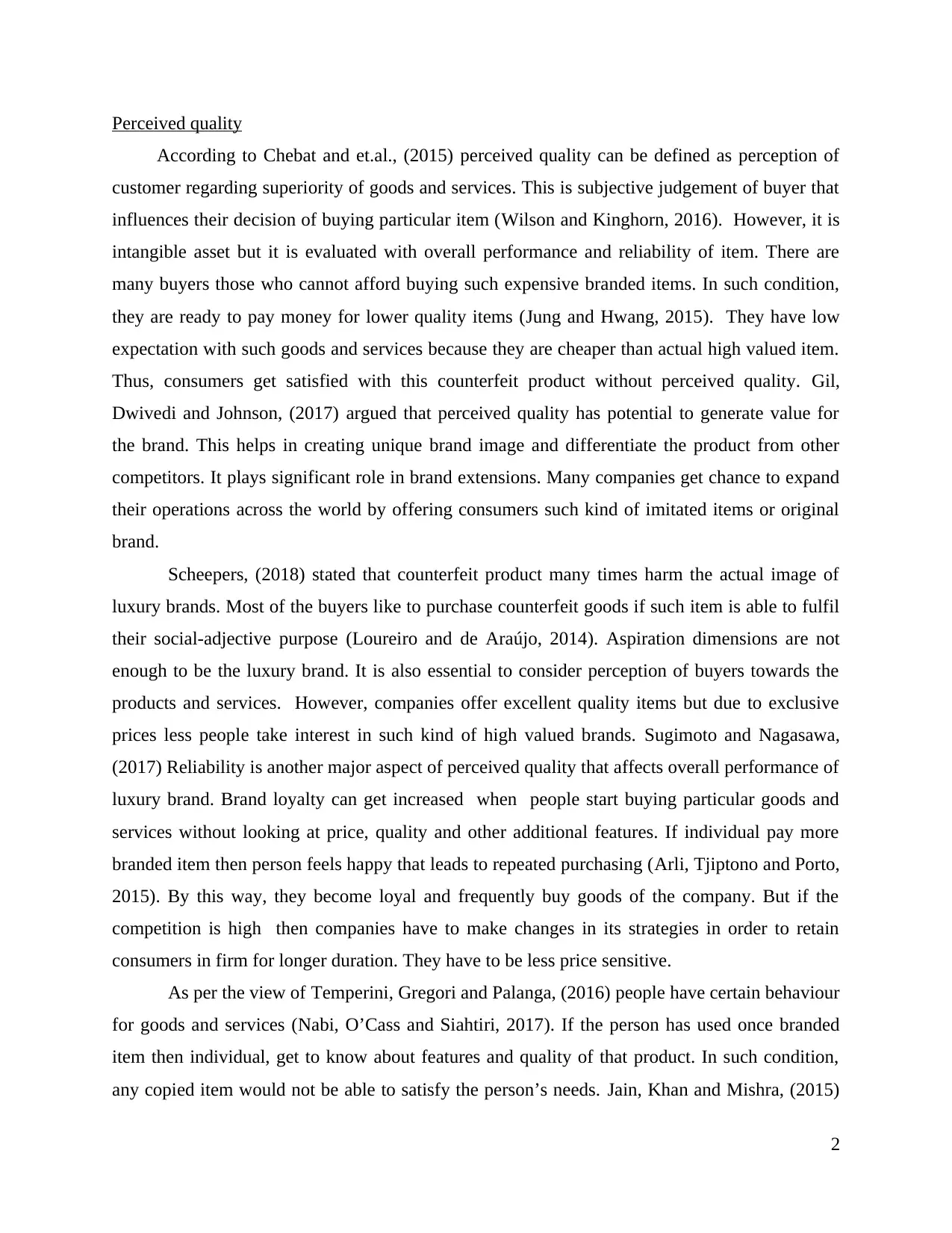
Perceived quality
According to Chebat and et.al., (2015) perceived quality can be defined as perception of
customer regarding superiority of goods and services. This is subjective judgement of buyer that
influences their decision of buying particular item (Wilson and Kinghorn, 2016). However, it is
intangible asset but it is evaluated with overall performance and reliability of item. There are
many buyers those who cannot afford buying such expensive branded items. In such condition,
they are ready to pay money for lower quality items (Jung and Hwang, 2015). They have low
expectation with such goods and services because they are cheaper than actual high valued item.
Thus, consumers get satisfied with this counterfeit product without perceived quality. Gil,
Dwivedi and Johnson, (2017) argued that perceived quality has potential to generate value for
the brand. This helps in creating unique brand image and differentiate the product from other
competitors. It plays significant role in brand extensions. Many companies get chance to expand
their operations across the world by offering consumers such kind of imitated items or original
brand.
Scheepers, (2018) stated that counterfeit product many times harm the actual image of
luxury brands. Most of the buyers like to purchase counterfeit goods if such item is able to fulfil
their social-adjective purpose (Loureiro and de Araújo, 2014). Aspiration dimensions are not
enough to be the luxury brand. It is also essential to consider perception of buyers towards the
products and services. However, companies offer excellent quality items but due to exclusive
prices less people take interest in such kind of high valued brands. Sugimoto and Nagasawa,
(2017) Reliability is another major aspect of perceived quality that affects overall performance of
luxury brand. Brand loyalty can get increased when people start buying particular goods and
services without looking at price, quality and other additional features. If individual pay more
branded item then person feels happy that leads to repeated purchasing (Arli, Tjiptono and Porto,
2015). By this way, they become loyal and frequently buy goods of the company. But if the
competition is high then companies have to make changes in its strategies in order to retain
consumers in firm for longer duration. They have to be less price sensitive.
As per the view of Temperini, Gregori and Palanga, (2016) people have certain behaviour
for goods and services (Nabi, O’Cass and Siahtiri, 2017). If the person has used once branded
item then individual, get to know about features and quality of that product. In such condition,
any copied item would not be able to satisfy the person’s needs. Jain, Khan and Mishra, (2015)
2
According to Chebat and et.al., (2015) perceived quality can be defined as perception of
customer regarding superiority of goods and services. This is subjective judgement of buyer that
influences their decision of buying particular item (Wilson and Kinghorn, 2016). However, it is
intangible asset but it is evaluated with overall performance and reliability of item. There are
many buyers those who cannot afford buying such expensive branded items. In such condition,
they are ready to pay money for lower quality items (Jung and Hwang, 2015). They have low
expectation with such goods and services because they are cheaper than actual high valued item.
Thus, consumers get satisfied with this counterfeit product without perceived quality. Gil,
Dwivedi and Johnson, (2017) argued that perceived quality has potential to generate value for
the brand. This helps in creating unique brand image and differentiate the product from other
competitors. It plays significant role in brand extensions. Many companies get chance to expand
their operations across the world by offering consumers such kind of imitated items or original
brand.
Scheepers, (2018) stated that counterfeit product many times harm the actual image of
luxury brands. Most of the buyers like to purchase counterfeit goods if such item is able to fulfil
their social-adjective purpose (Loureiro and de Araújo, 2014). Aspiration dimensions are not
enough to be the luxury brand. It is also essential to consider perception of buyers towards the
products and services. However, companies offer excellent quality items but due to exclusive
prices less people take interest in such kind of high valued brands. Sugimoto and Nagasawa,
(2017) Reliability is another major aspect of perceived quality that affects overall performance of
luxury brand. Brand loyalty can get increased when people start buying particular goods and
services without looking at price, quality and other additional features. If individual pay more
branded item then person feels happy that leads to repeated purchasing (Arli, Tjiptono and Porto,
2015). By this way, they become loyal and frequently buy goods of the company. But if the
competition is high then companies have to make changes in its strategies in order to retain
consumers in firm for longer duration. They have to be less price sensitive.
As per the view of Temperini, Gregori and Palanga, (2016) people have certain behaviour
for goods and services (Nabi, O’Cass and Siahtiri, 2017). If the person has used once branded
item then individual, get to know about features and quality of that product. In such condition,
any copied item would not be able to satisfy the person’s needs. Jain, Khan and Mishra, (2015)
2
Secure Best Marks with AI Grader
Need help grading? Try our AI Grader for instant feedback on your assignments.
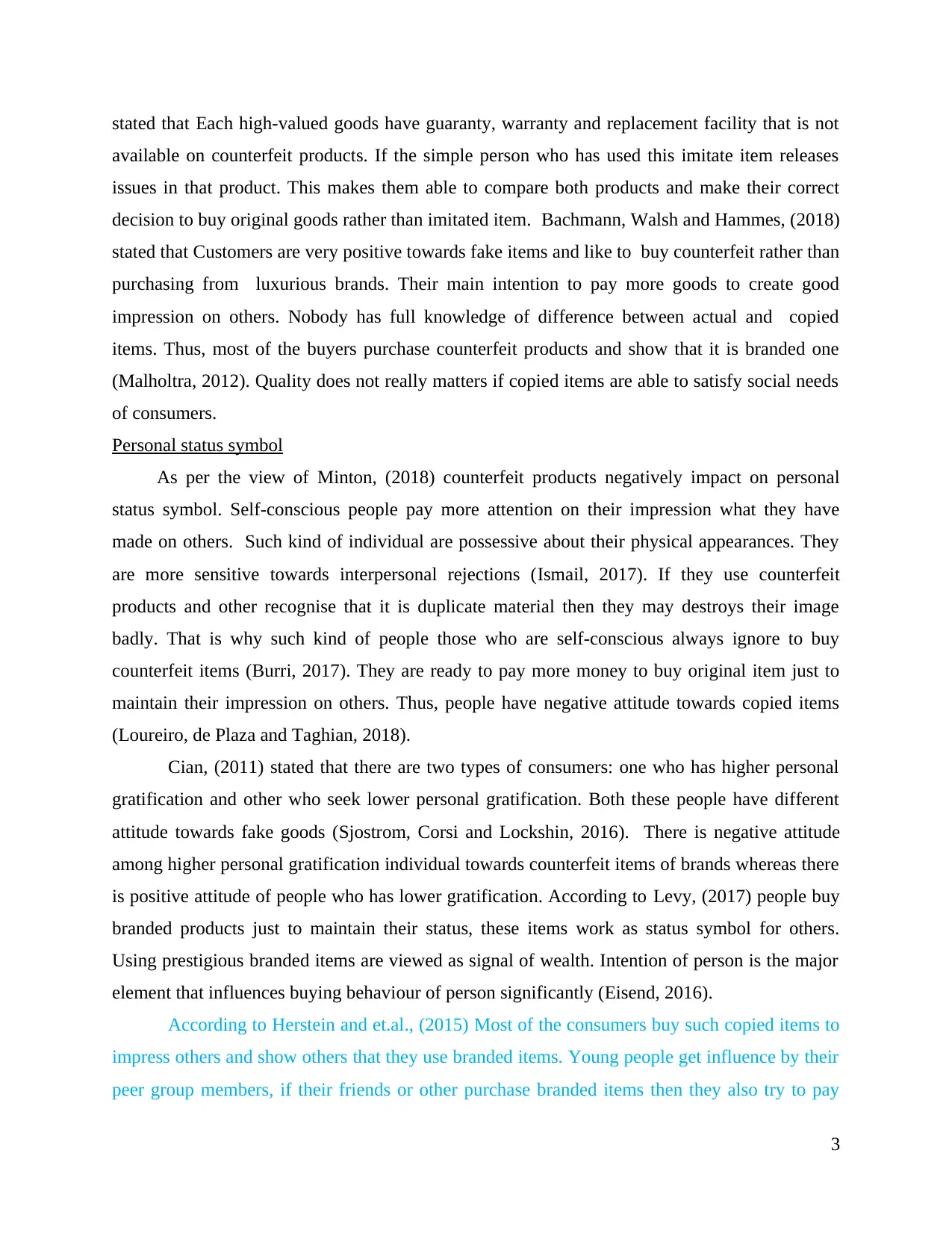
stated that Each high-valued goods have guaranty, warranty and replacement facility that is not
available on counterfeit products. If the simple person who has used this imitate item releases
issues in that product. This makes them able to compare both products and make their correct
decision to buy original goods rather than imitated item. Bachmann, Walsh and Hammes, (2018)
stated that Customers are very positive towards fake items and like to buy counterfeit rather than
purchasing from luxurious brands. Their main intention to pay more goods to create good
impression on others. Nobody has full knowledge of difference between actual and copied
items. Thus, most of the buyers purchase counterfeit products and show that it is branded one
(Malholtra, 2012). Quality does not really matters if copied items are able to satisfy social needs
of consumers.
Personal status symbol
As per the view of Minton, (2018) counterfeit products negatively impact on personal
status symbol. Self-conscious people pay more attention on their impression what they have
made on others. Such kind of individual are possessive about their physical appearances. They
are more sensitive towards interpersonal rejections (Ismail, 2017). If they use counterfeit
products and other recognise that it is duplicate material then they may destroys their image
badly. That is why such kind of people those who are self-conscious always ignore to buy
counterfeit items (Burri, 2017). They are ready to pay more money to buy original item just to
maintain their impression on others. Thus, people have negative attitude towards copied items
(Loureiro, de Plaza and Taghian, 2018).
Cian, (2011) stated that there are two types of consumers: one who has higher personal
gratification and other who seek lower personal gratification. Both these people have different
attitude towards fake goods (Sjostrom, Corsi and Lockshin, 2016). There is negative attitude
among higher personal gratification individual towards counterfeit items of brands whereas there
is positive attitude of people who has lower gratification. According to Levy, (2017) people buy
branded products just to maintain their status, these items work as status symbol for others.
Using prestigious branded items are viewed as signal of wealth. Intention of person is the major
element that influences buying behaviour of person significantly (Eisend, 2016).
According to Herstein and et.al., (2015) Most of the consumers buy such copied items to
impress others and show others that they use branded items. Young people get influence by their
peer group members, if their friends or other purchase branded items then they also try to pay
3
available on counterfeit products. If the simple person who has used this imitate item releases
issues in that product. This makes them able to compare both products and make their correct
decision to buy original goods rather than imitated item. Bachmann, Walsh and Hammes, (2018)
stated that Customers are very positive towards fake items and like to buy counterfeit rather than
purchasing from luxurious brands. Their main intention to pay more goods to create good
impression on others. Nobody has full knowledge of difference between actual and copied
items. Thus, most of the buyers purchase counterfeit products and show that it is branded one
(Malholtra, 2012). Quality does not really matters if copied items are able to satisfy social needs
of consumers.
Personal status symbol
As per the view of Minton, (2018) counterfeit products negatively impact on personal
status symbol. Self-conscious people pay more attention on their impression what they have
made on others. Such kind of individual are possessive about their physical appearances. They
are more sensitive towards interpersonal rejections (Ismail, 2017). If they use counterfeit
products and other recognise that it is duplicate material then they may destroys their image
badly. That is why such kind of people those who are self-conscious always ignore to buy
counterfeit items (Burri, 2017). They are ready to pay more money to buy original item just to
maintain their impression on others. Thus, people have negative attitude towards copied items
(Loureiro, de Plaza and Taghian, 2018).
Cian, (2011) stated that there are two types of consumers: one who has higher personal
gratification and other who seek lower personal gratification. Both these people have different
attitude towards fake goods (Sjostrom, Corsi and Lockshin, 2016). There is negative attitude
among higher personal gratification individual towards counterfeit items of brands whereas there
is positive attitude of people who has lower gratification. According to Levy, (2017) people buy
branded products just to maintain their status, these items work as status symbol for others.
Using prestigious branded items are viewed as signal of wealth. Intention of person is the major
element that influences buying behaviour of person significantly (Eisend, 2016).
According to Herstein and et.al., (2015) Most of the consumers buy such copied items to
impress others and show others that they use branded items. Young people get influence by their
peer group members, if their friends or other purchase branded items then they also try to pay
3
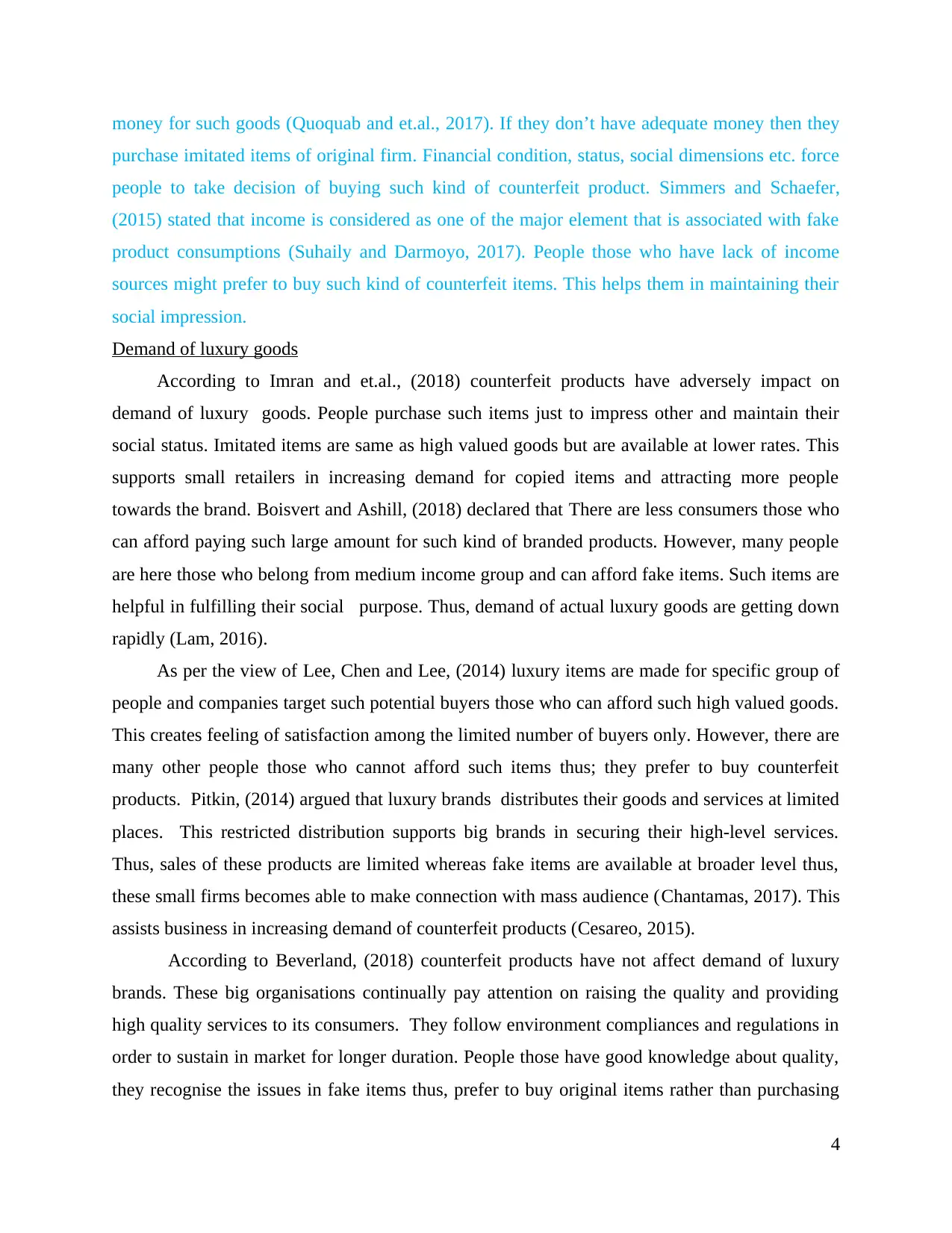
money for such goods (Quoquab and et.al., 2017). If they don’t have adequate money then they
purchase imitated items of original firm. Financial condition, status, social dimensions etc. force
people to take decision of buying such kind of counterfeit product. Simmers and Schaefer,
(2015) stated that income is considered as one of the major element that is associated with fake
product consumptions (Suhaily and Darmoyo, 2017). People those who have lack of income
sources might prefer to buy such kind of counterfeit items. This helps them in maintaining their
social impression.
Demand of luxury goods
According to Imran and et.al., (2018) counterfeit products have adversely impact on
demand of luxury goods. People purchase such items just to impress other and maintain their
social status. Imitated items are same as high valued goods but are available at lower rates. This
supports small retailers in increasing demand for copied items and attracting more people
towards the brand. Boisvert and Ashill, (2018) declared that There are less consumers those who
can afford paying such large amount for such kind of branded products. However, many people
are here those who belong from medium income group and can afford fake items. Such items are
helpful in fulfilling their social purpose. Thus, demand of actual luxury goods are getting down
rapidly (Lam, 2016).
As per the view of Lee, Chen and Lee, (2014) luxury items are made for specific group of
people and companies target such potential buyers those who can afford such high valued goods.
This creates feeling of satisfaction among the limited number of buyers only. However, there are
many other people those who cannot afford such items thus; they prefer to buy counterfeit
products. Pitkin, (2014) argued that luxury brands distributes their goods and services at limited
places. This restricted distribution supports big brands in securing their high-level services.
Thus, sales of these products are limited whereas fake items are available at broader level thus,
these small firms becomes able to make connection with mass audience (Chantamas, 2017). This
assists business in increasing demand of counterfeit products (Cesareo, 2015).
According to Beverland, (2018) counterfeit products have not affect demand of luxury
brands. These big organisations continually pay attention on raising the quality and providing
high quality services to its consumers. They follow environment compliances and regulations in
order to sustain in market for longer duration. People those have good knowledge about quality,
they recognise the issues in fake items thus, prefer to buy original items rather than purchasing
4
purchase imitated items of original firm. Financial condition, status, social dimensions etc. force
people to take decision of buying such kind of counterfeit product. Simmers and Schaefer,
(2015) stated that income is considered as one of the major element that is associated with fake
product consumptions (Suhaily and Darmoyo, 2017). People those who have lack of income
sources might prefer to buy such kind of counterfeit items. This helps them in maintaining their
social impression.
Demand of luxury goods
According to Imran and et.al., (2018) counterfeit products have adversely impact on
demand of luxury goods. People purchase such items just to impress other and maintain their
social status. Imitated items are same as high valued goods but are available at lower rates. This
supports small retailers in increasing demand for copied items and attracting more people
towards the brand. Boisvert and Ashill, (2018) declared that There are less consumers those who
can afford paying such large amount for such kind of branded products. However, many people
are here those who belong from medium income group and can afford fake items. Such items are
helpful in fulfilling their social purpose. Thus, demand of actual luxury goods are getting down
rapidly (Lam, 2016).
As per the view of Lee, Chen and Lee, (2014) luxury items are made for specific group of
people and companies target such potential buyers those who can afford such high valued goods.
This creates feeling of satisfaction among the limited number of buyers only. However, there are
many other people those who cannot afford such items thus; they prefer to buy counterfeit
products. Pitkin, (2014) argued that luxury brands distributes their goods and services at limited
places. This restricted distribution supports big brands in securing their high-level services.
Thus, sales of these products are limited whereas fake items are available at broader level thus,
these small firms becomes able to make connection with mass audience (Chantamas, 2017). This
assists business in increasing demand of counterfeit products (Cesareo, 2015).
According to Beverland, (2018) counterfeit products have not affect demand of luxury
brands. These big organisations continually pay attention on raising the quality and providing
high quality services to its consumers. They follow environment compliances and regulations in
order to sustain in market for longer duration. People those have good knowledge about quality,
they recognise the issues in fake items thus, prefer to buy original items rather than purchasing
4
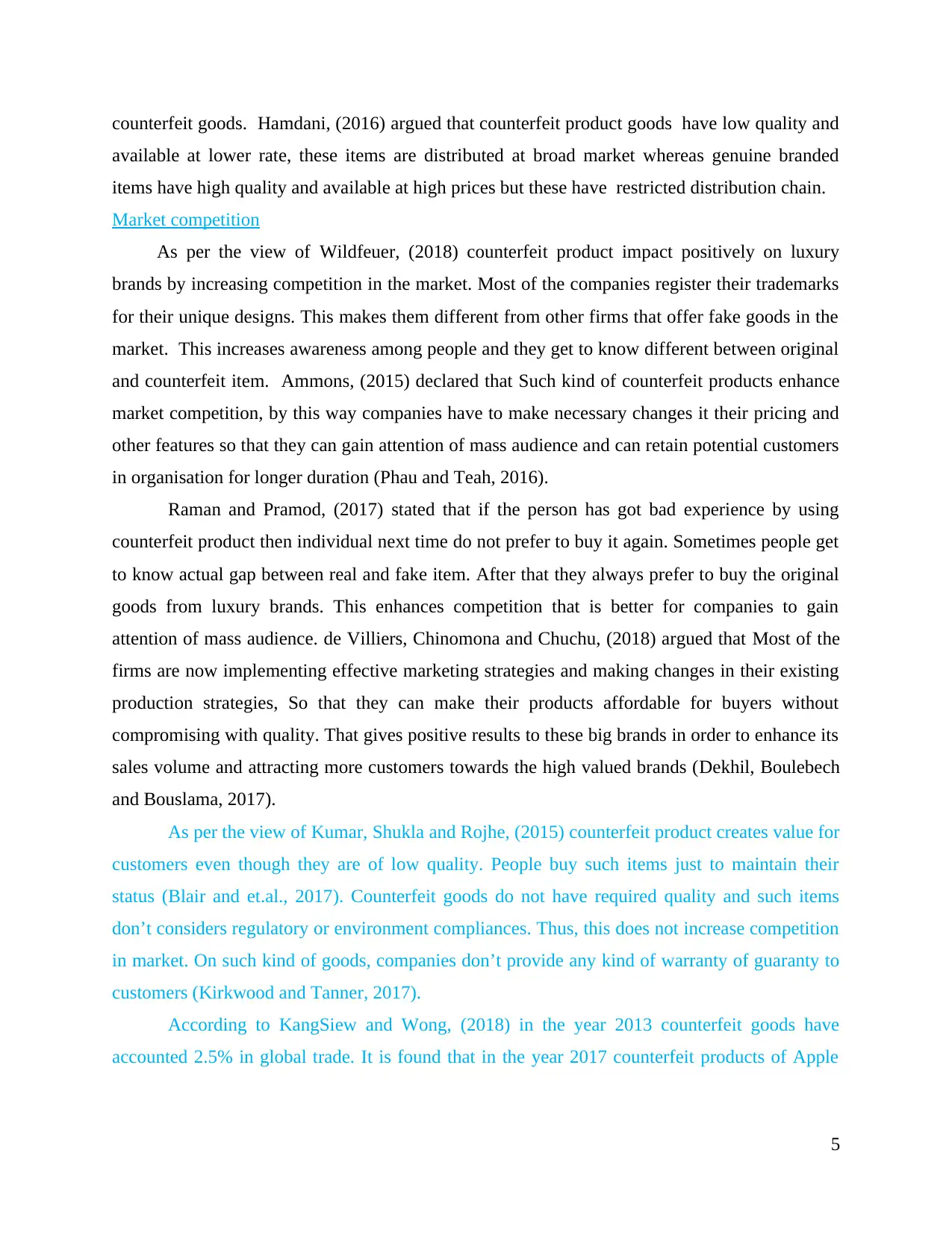
counterfeit goods. Hamdani, (2016) argued that counterfeit product goods have low quality and
available at lower rate, these items are distributed at broad market whereas genuine branded
items have high quality and available at high prices but these have restricted distribution chain.
Market competition
As per the view of Wildfeuer, (2018) counterfeit product impact positively on luxury
brands by increasing competition in the market. Most of the companies register their trademarks
for their unique designs. This makes them different from other firms that offer fake goods in the
market. This increases awareness among people and they get to know different between original
and counterfeit item. Ammons, (2015) declared that Such kind of counterfeit products enhance
market competition, by this way companies have to make necessary changes it their pricing and
other features so that they can gain attention of mass audience and can retain potential customers
in organisation for longer duration (Phau and Teah, 2016).
Raman and Pramod, (2017) stated that if the person has got bad experience by using
counterfeit product then individual next time do not prefer to buy it again. Sometimes people get
to know actual gap between real and fake item. After that they always prefer to buy the original
goods from luxury brands. This enhances competition that is better for companies to gain
attention of mass audience. de Villiers, Chinomona and Chuchu, (2018) argued that Most of the
firms are now implementing effective marketing strategies and making changes in their existing
production strategies, So that they can make their products affordable for buyers without
compromising with quality. That gives positive results to these big brands in order to enhance its
sales volume and attracting more customers towards the high valued brands (Dekhil, Boulebech
and Bouslama, 2017).
As per the view of Kumar, Shukla and Rojhe, (2015) counterfeit product creates value for
customers even though they are of low quality. People buy such items just to maintain their
status (Blair and et.al., 2017). Counterfeit goods do not have required quality and such items
don’t considers regulatory or environment compliances. Thus, this does not increase competition
in market. On such kind of goods, companies don’t provide any kind of warranty of guaranty to
customers (Kirkwood and Tanner, 2017).
According to KangSiew and Wong, (2018) in the year 2013 counterfeit goods have
accounted 2.5% in global trade. It is found that in the year 2017 counterfeit products of Apple
5
available at lower rate, these items are distributed at broad market whereas genuine branded
items have high quality and available at high prices but these have restricted distribution chain.
Market competition
As per the view of Wildfeuer, (2018) counterfeit product impact positively on luxury
brands by increasing competition in the market. Most of the companies register their trademarks
for their unique designs. This makes them different from other firms that offer fake goods in the
market. This increases awareness among people and they get to know different between original
and counterfeit item. Ammons, (2015) declared that Such kind of counterfeit products enhance
market competition, by this way companies have to make necessary changes it their pricing and
other features so that they can gain attention of mass audience and can retain potential customers
in organisation for longer duration (Phau and Teah, 2016).
Raman and Pramod, (2017) stated that if the person has got bad experience by using
counterfeit product then individual next time do not prefer to buy it again. Sometimes people get
to know actual gap between real and fake item. After that they always prefer to buy the original
goods from luxury brands. This enhances competition that is better for companies to gain
attention of mass audience. de Villiers, Chinomona and Chuchu, (2018) argued that Most of the
firms are now implementing effective marketing strategies and making changes in their existing
production strategies, So that they can make their products affordable for buyers without
compromising with quality. That gives positive results to these big brands in order to enhance its
sales volume and attracting more customers towards the high valued brands (Dekhil, Boulebech
and Bouslama, 2017).
As per the view of Kumar, Shukla and Rojhe, (2015) counterfeit product creates value for
customers even though they are of low quality. People buy such items just to maintain their
status (Blair and et.al., 2017). Counterfeit goods do not have required quality and such items
don’t considers regulatory or environment compliances. Thus, this does not increase competition
in market. On such kind of goods, companies don’t provide any kind of warranty of guaranty to
customers (Kirkwood and Tanner, 2017).
According to KangSiew and Wong, (2018) in the year 2013 counterfeit goods have
accounted 2.5% in global trade. It is found that in the year 2017 counterfeit products of Apple
5
Paraphrase This Document
Need a fresh take? Get an instant paraphrase of this document with our AI Paraphraser
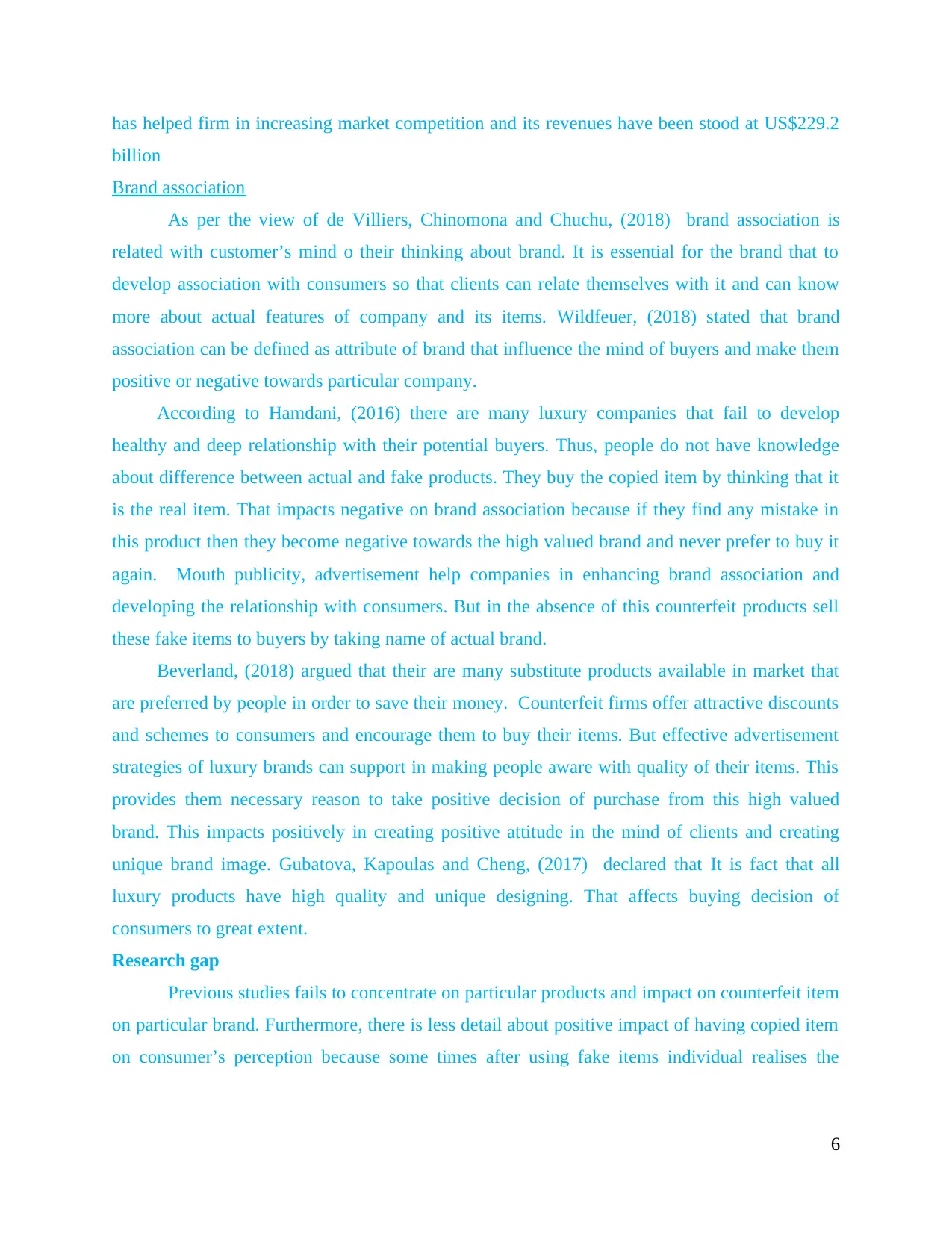
has helped firm in increasing market competition and its revenues have been stood at US$229.2
billion
Brand association
As per the view of de Villiers, Chinomona and Chuchu, (2018) brand association is
related with customer’s mind o their thinking about brand. It is essential for the brand that to
develop association with consumers so that clients can relate themselves with it and can know
more about actual features of company and its items. Wildfeuer, (2018) stated that brand
association can be defined as attribute of brand that influence the mind of buyers and make them
positive or negative towards particular company.
According to Hamdani, (2016) there are many luxury companies that fail to develop
healthy and deep relationship with their potential buyers. Thus, people do not have knowledge
about difference between actual and fake products. They buy the copied item by thinking that it
is the real item. That impacts negative on brand association because if they find any mistake in
this product then they become negative towards the high valued brand and never prefer to buy it
again. Mouth publicity, advertisement help companies in enhancing brand association and
developing the relationship with consumers. But in the absence of this counterfeit products sell
these fake items to buyers by taking name of actual brand.
Beverland, (2018) argued that their are many substitute products available in market that
are preferred by people in order to save their money. Counterfeit firms offer attractive discounts
and schemes to consumers and encourage them to buy their items. But effective advertisement
strategies of luxury brands can support in making people aware with quality of their items. This
provides them necessary reason to take positive decision of purchase from this high valued
brand. This impacts positively in creating positive attitude in the mind of clients and creating
unique brand image. Gubatova, Kapoulas and Cheng, (2017) declared that It is fact that all
luxury products have high quality and unique designing. That affects buying decision of
consumers to great extent.
Research gap
Previous studies fails to concentrate on particular products and impact on counterfeit item
on particular brand. Furthermore, there is less detail about positive impact of having copied item
on consumer’s perception because some times after using fake items individual realises the
6
billion
Brand association
As per the view of de Villiers, Chinomona and Chuchu, (2018) brand association is
related with customer’s mind o their thinking about brand. It is essential for the brand that to
develop association with consumers so that clients can relate themselves with it and can know
more about actual features of company and its items. Wildfeuer, (2018) stated that brand
association can be defined as attribute of brand that influence the mind of buyers and make them
positive or negative towards particular company.
According to Hamdani, (2016) there are many luxury companies that fail to develop
healthy and deep relationship with their potential buyers. Thus, people do not have knowledge
about difference between actual and fake products. They buy the copied item by thinking that it
is the real item. That impacts negative on brand association because if they find any mistake in
this product then they become negative towards the high valued brand and never prefer to buy it
again. Mouth publicity, advertisement help companies in enhancing brand association and
developing the relationship with consumers. But in the absence of this counterfeit products sell
these fake items to buyers by taking name of actual brand.
Beverland, (2018) argued that their are many substitute products available in market that
are preferred by people in order to save their money. Counterfeit firms offer attractive discounts
and schemes to consumers and encourage them to buy their items. But effective advertisement
strategies of luxury brands can support in making people aware with quality of their items. This
provides them necessary reason to take positive decision of purchase from this high valued
brand. This impacts positively in creating positive attitude in the mind of clients and creating
unique brand image. Gubatova, Kapoulas and Cheng, (2017) declared that It is fact that all
luxury products have high quality and unique designing. That affects buying decision of
consumers to great extent.
Research gap
Previous studies fails to concentrate on particular products and impact on counterfeit item
on particular brand. Furthermore, there is less detail about positive impact of having copied item
on consumer’s perception because some times after using fake items individual realises the
6
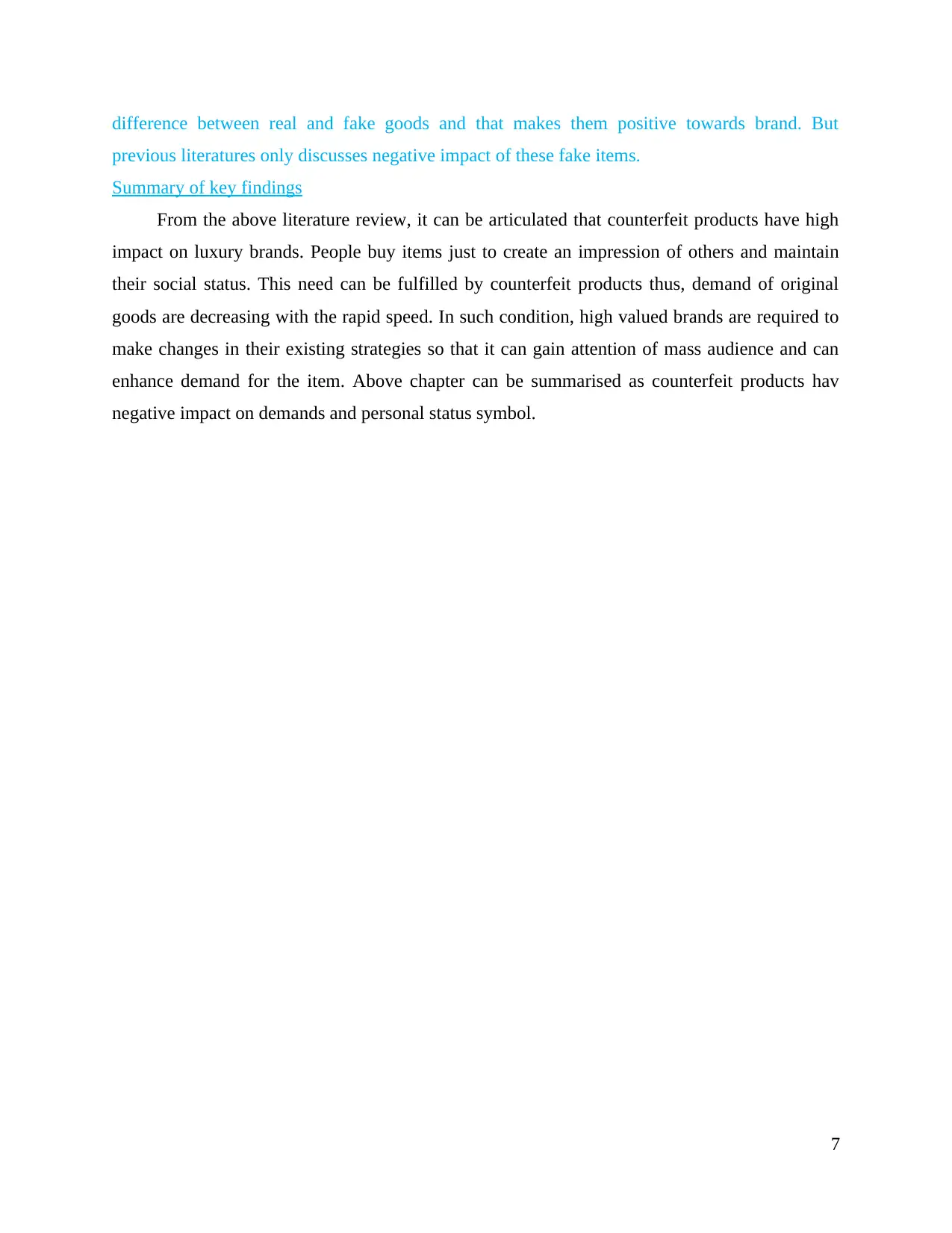
difference between real and fake goods and that makes them positive towards brand. But
previous literatures only discusses negative impact of these fake items.
Summary of key findings
From the above literature review, it can be articulated that counterfeit products have high
impact on luxury brands. People buy items just to create an impression of others and maintain
their social status. This need can be fulfilled by counterfeit products thus, demand of original
goods are decreasing with the rapid speed. In such condition, high valued brands are required to
make changes in their existing strategies so that it can gain attention of mass audience and can
enhance demand for the item. Above chapter can be summarised as counterfeit products hav
negative impact on demands and personal status symbol.
7
previous literatures only discusses negative impact of these fake items.
Summary of key findings
From the above literature review, it can be articulated that counterfeit products have high
impact on luxury brands. People buy items just to create an impression of others and maintain
their social status. This need can be fulfilled by counterfeit products thus, demand of original
goods are decreasing with the rapid speed. In such condition, high valued brands are required to
make changes in their existing strategies so that it can gain attention of mass audience and can
enhance demand for the item. Above chapter can be summarised as counterfeit products hav
negative impact on demands and personal status symbol.
7
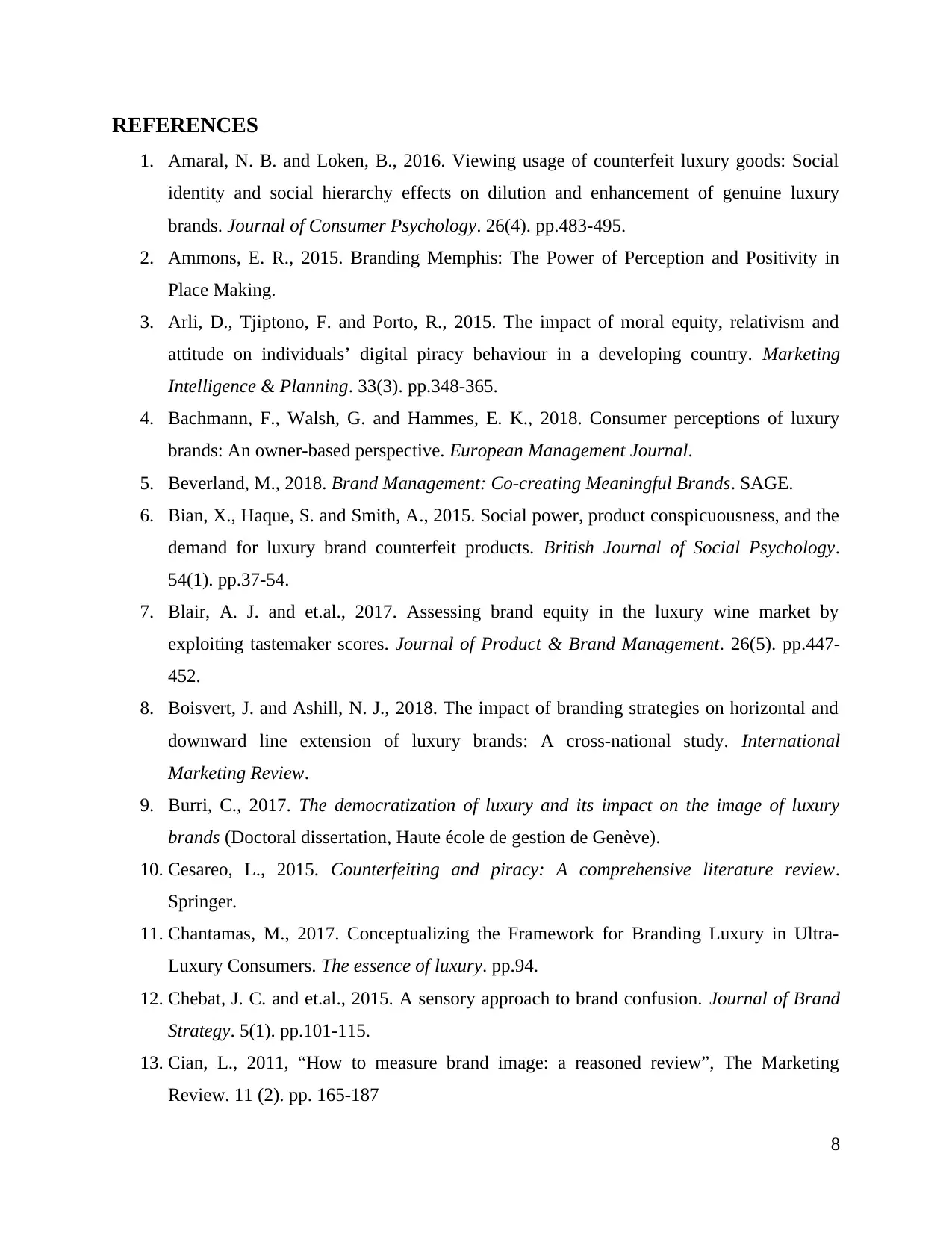
REFERENCES
1. Amaral, N. B. and Loken, B., 2016. Viewing usage of counterfeit luxury goods: Social
identity and social hierarchy effects on dilution and enhancement of genuine luxury
brands. Journal of Consumer Psychology. 26(4). pp.483-495.
2. Ammons, E. R., 2015. Branding Memphis: The Power of Perception and Positivity in
Place Making.
3. Arli, D., Tjiptono, F. and Porto, R., 2015. The impact of moral equity, relativism and
attitude on individuals’ digital piracy behaviour in a developing country. Marketing
Intelligence & Planning. 33(3). pp.348-365.
4. Bachmann, F., Walsh, G. and Hammes, E. K., 2018. Consumer perceptions of luxury
brands: An owner-based perspective. European Management Journal.
5. Beverland, M., 2018. Brand Management: Co-creating Meaningful Brands. SAGE.
6. Bian, X., Haque, S. and Smith, A., 2015. Social power, product conspicuousness, and the
demand for luxury brand counterfeit products. British Journal of Social Psychology.
54(1). pp.37-54.
7. Blair, A. J. and et.al., 2017. Assessing brand equity in the luxury wine market by
exploiting tastemaker scores. Journal of Product & Brand Management. 26(5). pp.447-
452.
8. Boisvert, J. and Ashill, N. J., 2018. The impact of branding strategies on horizontal and
downward line extension of luxury brands: A cross-national study. International
Marketing Review.
9. Burri, C., 2017. The democratization of luxury and its impact on the image of luxury
brands (Doctoral dissertation, Haute école de gestion de Genève).
10. Cesareo, L., 2015. Counterfeiting and piracy: A comprehensive literature review.
Springer.
11. Chantamas, M., 2017. Conceptualizing the Framework for Branding Luxury in Ultra-
Luxury Consumers. The essence of luxury. pp.94.
12. Chebat, J. C. and et.al., 2015. A sensory approach to brand confusion. Journal of Brand
Strategy. 5(1). pp.101-115.
13. Cian, L., 2011, “How to measure brand image: a reasoned review”, The Marketing
Review. 11 (2). pp. 165-187
8
1. Amaral, N. B. and Loken, B., 2016. Viewing usage of counterfeit luxury goods: Social
identity and social hierarchy effects on dilution and enhancement of genuine luxury
brands. Journal of Consumer Psychology. 26(4). pp.483-495.
2. Ammons, E. R., 2015. Branding Memphis: The Power of Perception and Positivity in
Place Making.
3. Arli, D., Tjiptono, F. and Porto, R., 2015. The impact of moral equity, relativism and
attitude on individuals’ digital piracy behaviour in a developing country. Marketing
Intelligence & Planning. 33(3). pp.348-365.
4. Bachmann, F., Walsh, G. and Hammes, E. K., 2018. Consumer perceptions of luxury
brands: An owner-based perspective. European Management Journal.
5. Beverland, M., 2018. Brand Management: Co-creating Meaningful Brands. SAGE.
6. Bian, X., Haque, S. and Smith, A., 2015. Social power, product conspicuousness, and the
demand for luxury brand counterfeit products. British Journal of Social Psychology.
54(1). pp.37-54.
7. Blair, A. J. and et.al., 2017. Assessing brand equity in the luxury wine market by
exploiting tastemaker scores. Journal of Product & Brand Management. 26(5). pp.447-
452.
8. Boisvert, J. and Ashill, N. J., 2018. The impact of branding strategies on horizontal and
downward line extension of luxury brands: A cross-national study. International
Marketing Review.
9. Burri, C., 2017. The democratization of luxury and its impact on the image of luxury
brands (Doctoral dissertation, Haute école de gestion de Genève).
10. Cesareo, L., 2015. Counterfeiting and piracy: A comprehensive literature review.
Springer.
11. Chantamas, M., 2017. Conceptualizing the Framework for Branding Luxury in Ultra-
Luxury Consumers. The essence of luxury. pp.94.
12. Chebat, J. C. and et.al., 2015. A sensory approach to brand confusion. Journal of Brand
Strategy. 5(1). pp.101-115.
13. Cian, L., 2011, “How to measure brand image: a reasoned review”, The Marketing
Review. 11 (2). pp. 165-187
8
Secure Best Marks with AI Grader
Need help grading? Try our AI Grader for instant feedback on your assignments.
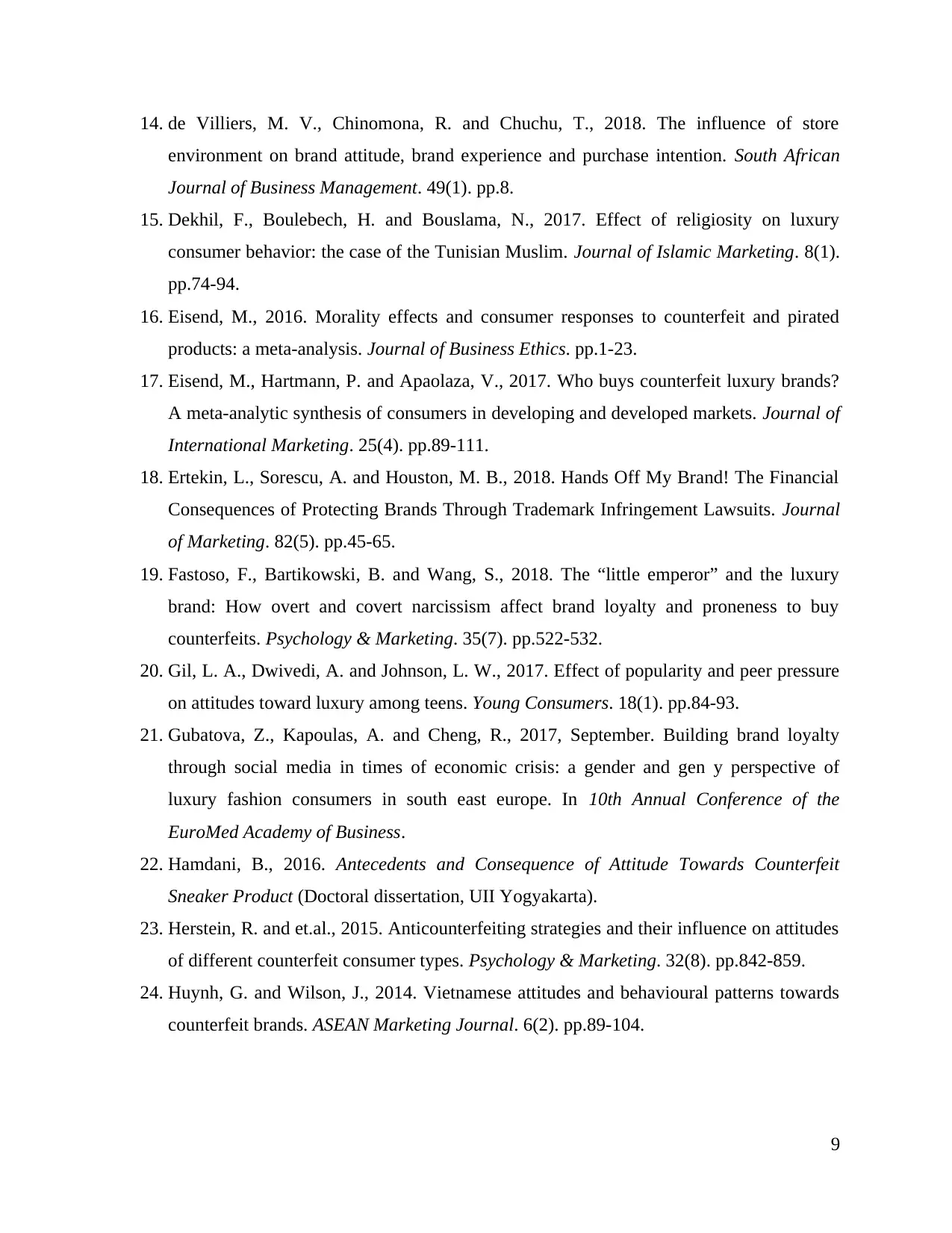
14. de Villiers, M. V., Chinomona, R. and Chuchu, T., 2018. The influence of store
environment on brand attitude, brand experience and purchase intention. South African
Journal of Business Management. 49(1). pp.8.
15. Dekhil, F., Boulebech, H. and Bouslama, N., 2017. Effect of religiosity on luxury
consumer behavior: the case of the Tunisian Muslim. Journal of Islamic Marketing. 8(1).
pp.74-94.
16. Eisend, M., 2016. Morality effects and consumer responses to counterfeit and pirated
products: a meta-analysis. Journal of Business Ethics. pp.1-23.
17. Eisend, M., Hartmann, P. and Apaolaza, V., 2017. Who buys counterfeit luxury brands?
A meta-analytic synthesis of consumers in developing and developed markets. Journal of
International Marketing. 25(4). pp.89-111.
18. Ertekin, L., Sorescu, A. and Houston, M. B., 2018. Hands Off My Brand! The Financial
Consequences of Protecting Brands Through Trademark Infringement Lawsuits. Journal
of Marketing. 82(5). pp.45-65.
19. Fastoso, F., Bartikowski, B. and Wang, S., 2018. The “little emperor” and the luxury
brand: How overt and covert narcissism affect brand loyalty and proneness to buy
counterfeits. Psychology & Marketing. 35(7). pp.522-532.
20. Gil, L. A., Dwivedi, A. and Johnson, L. W., 2017. Effect of popularity and peer pressure
on attitudes toward luxury among teens. Young Consumers. 18(1). pp.84-93.
21. Gubatova, Z., Kapoulas, A. and Cheng, R., 2017, September. Building brand loyalty
through social media in times of economic crisis: a gender and gen y perspective of
luxury fashion consumers in south east europe. In 10th Annual Conference of the
EuroMed Academy of Business.
22. Hamdani, B., 2016. Antecedents and Consequence of Attitude Towards Counterfeit
Sneaker Product (Doctoral dissertation, UII Yogyakarta).
23. Herstein, R. and et.al., 2015. Anticounterfeiting strategies and their influence on attitudes
of different counterfeit consumer types. Psychology & Marketing. 32(8). pp.842-859.
24. Huynh, G. and Wilson, J., 2014. Vietnamese attitudes and behavioural patterns towards
counterfeit brands. ASEAN Marketing Journal. 6(2). pp.89-104.
9
environment on brand attitude, brand experience and purchase intention. South African
Journal of Business Management. 49(1). pp.8.
15. Dekhil, F., Boulebech, H. and Bouslama, N., 2017. Effect of religiosity on luxury
consumer behavior: the case of the Tunisian Muslim. Journal of Islamic Marketing. 8(1).
pp.74-94.
16. Eisend, M., 2016. Morality effects and consumer responses to counterfeit and pirated
products: a meta-analysis. Journal of Business Ethics. pp.1-23.
17. Eisend, M., Hartmann, P. and Apaolaza, V., 2017. Who buys counterfeit luxury brands?
A meta-analytic synthesis of consumers in developing and developed markets. Journal of
International Marketing. 25(4). pp.89-111.
18. Ertekin, L., Sorescu, A. and Houston, M. B., 2018. Hands Off My Brand! The Financial
Consequences of Protecting Brands Through Trademark Infringement Lawsuits. Journal
of Marketing. 82(5). pp.45-65.
19. Fastoso, F., Bartikowski, B. and Wang, S., 2018. The “little emperor” and the luxury
brand: How overt and covert narcissism affect brand loyalty and proneness to buy
counterfeits. Psychology & Marketing. 35(7). pp.522-532.
20. Gil, L. A., Dwivedi, A. and Johnson, L. W., 2017. Effect of popularity and peer pressure
on attitudes toward luxury among teens. Young Consumers. 18(1). pp.84-93.
21. Gubatova, Z., Kapoulas, A. and Cheng, R., 2017, September. Building brand loyalty
through social media in times of economic crisis: a gender and gen y perspective of
luxury fashion consumers in south east europe. In 10th Annual Conference of the
EuroMed Academy of Business.
22. Hamdani, B., 2016. Antecedents and Consequence of Attitude Towards Counterfeit
Sneaker Product (Doctoral dissertation, UII Yogyakarta).
23. Herstein, R. and et.al., 2015. Anticounterfeiting strategies and their influence on attitudes
of different counterfeit consumer types. Psychology & Marketing. 32(8). pp.842-859.
24. Huynh, G. and Wilson, J., 2014. Vietnamese attitudes and behavioural patterns towards
counterfeit brands. ASEAN Marketing Journal. 6(2). pp.89-104.
9
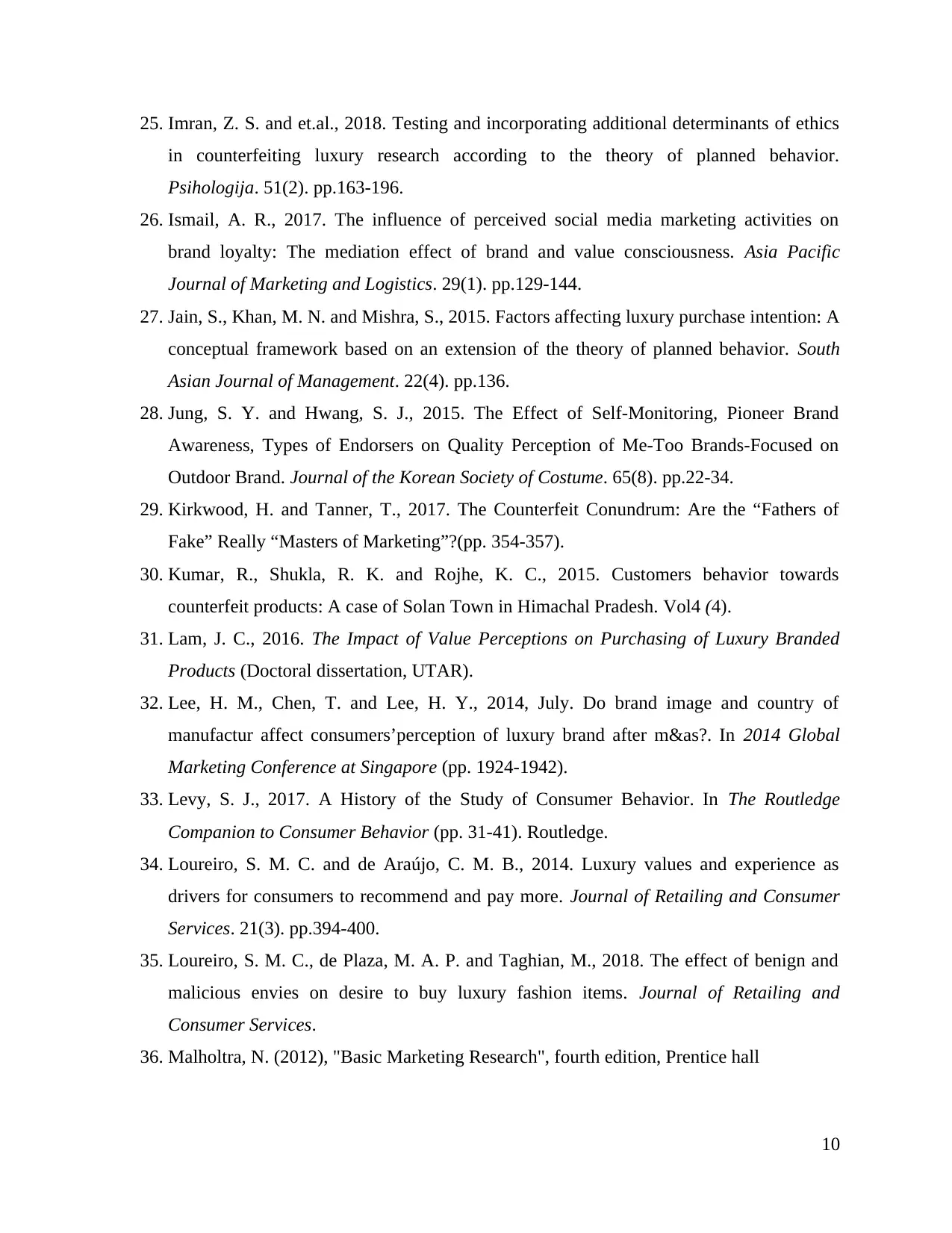
25. Imran, Z. S. and et.al., 2018. Testing and incorporating additional determinants of ethics
in counterfeiting luxury research according to the theory of planned behavior.
Psihologija. 51(2). pp.163-196.
26. Ismail, A. R., 2017. The influence of perceived social media marketing activities on
brand loyalty: The mediation effect of brand and value consciousness. Asia Pacific
Journal of Marketing and Logistics. 29(1). pp.129-144.
27. Jain, S., Khan, M. N. and Mishra, S., 2015. Factors affecting luxury purchase intention: A
conceptual framework based on an extension of the theory of planned behavior. South
Asian Journal of Management. 22(4). pp.136.
28. Jung, S. Y. and Hwang, S. J., 2015. The Effect of Self-Monitoring, Pioneer Brand
Awareness, Types of Endorsers on Quality Perception of Me-Too Brands-Focused on
Outdoor Brand. Journal of the Korean Society of Costume. 65(8). pp.22-34.
29. Kirkwood, H. and Tanner, T., 2017. The Counterfeit Conundrum: Are the “Fathers of
Fake” Really “Masters of Marketing”?(pp. 354-357).
30. Kumar, R., Shukla, R. K. and Rojhe, K. C., 2015. Customers behavior towards
counterfeit products: A case of Solan Town in Himachal Pradesh. Vol4 (4).
31. Lam, J. C., 2016. The Impact of Value Perceptions on Purchasing of Luxury Branded
Products (Doctoral dissertation, UTAR).
32. Lee, H. M., Chen, T. and Lee, H. Y., 2014, July. Do brand image and country of
manufactur affect consumers’perception of luxury brand after m&as?. In 2014 Global
Marketing Conference at Singapore (pp. 1924-1942).
33. Levy, S. J., 2017. A History of the Study of Consumer Behavior. In The Routledge
Companion to Consumer Behavior (pp. 31-41). Routledge.
34. Loureiro, S. M. C. and de Araújo, C. M. B., 2014. Luxury values and experience as
drivers for consumers to recommend and pay more. Journal of Retailing and Consumer
Services. 21(3). pp.394-400.
35. Loureiro, S. M. C., de Plaza, M. A. P. and Taghian, M., 2018. The effect of benign and
malicious envies on desire to buy luxury fashion items. Journal of Retailing and
Consumer Services.
36. Malholtra, N. (2012), "Basic Marketing Research", fourth edition, Prentice hall
10
in counterfeiting luxury research according to the theory of planned behavior.
Psihologija. 51(2). pp.163-196.
26. Ismail, A. R., 2017. The influence of perceived social media marketing activities on
brand loyalty: The mediation effect of brand and value consciousness. Asia Pacific
Journal of Marketing and Logistics. 29(1). pp.129-144.
27. Jain, S., Khan, M. N. and Mishra, S., 2015. Factors affecting luxury purchase intention: A
conceptual framework based on an extension of the theory of planned behavior. South
Asian Journal of Management. 22(4). pp.136.
28. Jung, S. Y. and Hwang, S. J., 2015. The Effect of Self-Monitoring, Pioneer Brand
Awareness, Types of Endorsers on Quality Perception of Me-Too Brands-Focused on
Outdoor Brand. Journal of the Korean Society of Costume. 65(8). pp.22-34.
29. Kirkwood, H. and Tanner, T., 2017. The Counterfeit Conundrum: Are the “Fathers of
Fake” Really “Masters of Marketing”?(pp. 354-357).
30. Kumar, R., Shukla, R. K. and Rojhe, K. C., 2015. Customers behavior towards
counterfeit products: A case of Solan Town in Himachal Pradesh. Vol4 (4).
31. Lam, J. C., 2016. The Impact of Value Perceptions on Purchasing of Luxury Branded
Products (Doctoral dissertation, UTAR).
32. Lee, H. M., Chen, T. and Lee, H. Y., 2014, July. Do brand image and country of
manufactur affect consumers’perception of luxury brand after m&as?. In 2014 Global
Marketing Conference at Singapore (pp. 1924-1942).
33. Levy, S. J., 2017. A History of the Study of Consumer Behavior. In The Routledge
Companion to Consumer Behavior (pp. 31-41). Routledge.
34. Loureiro, S. M. C. and de Araújo, C. M. B., 2014. Luxury values and experience as
drivers for consumers to recommend and pay more. Journal of Retailing and Consumer
Services. 21(3). pp.394-400.
35. Loureiro, S. M. C., de Plaza, M. A. P. and Taghian, M., 2018. The effect of benign and
malicious envies on desire to buy luxury fashion items. Journal of Retailing and
Consumer Services.
36. Malholtra, N. (2012), "Basic Marketing Research", fourth edition, Prentice hall
10

37. Minton, M., 2018. Will ‘Green’be the ‘New Black’?: investigating how sustainability
impacts perceptions of brand and product value in the luxury sector (Master's thesis).
38. Nabi, N., O’Cass, A. and Siahtiri, V., 2017. Status consumption in newly emerging
countries: The influence of personality traits and the mediating role of motivation to
consume conspicuously. Journal of Retailing and Consumer Services.
39. Phau, I. and Teah, M., 2016. The influence of brand mimicry on luxury brands. Luxury
Research Journal. 1(2). pp.93-109.
40. Pitkin, D. L., 2014. Counterfeiting and its link to organized crime and terrorism: Efforts
to tackle the suppy side of this threat, and the use of this lethal connection to deter
consumer demand (Doctoral dissertation, Utica College).
41. Quoquab, F. and et.al., 2017. Factors affecting consumers’ intention to purchase
counterfeit product: Empirical study in the Malaysian market. Asia Pacific Journal of
Marketing and Logistics. 29(4). pp.837-853.
42. Raman, R. and Pramod, D., 2017. A Strategic Approach Using Governance, Risk and
Compliance Model to Deal with Online Counterfeit Market. Journal of theoretical and
applied electronic commerce research. 12(3). pp.13-26.
43. Scheepers, S., 2018. Luxury value perceptions that drive South African female
consumers' purchase intent for luxury exotic leather accesories (Doctoral dissertation,
University of Pretoria).
44. Simmers, C. S. and Schaefer, A. D., 2015. Counterfeit luxury goods purchase motivation:
A cultural comparison. Journal of International Business and Cultural Studies Volume.
45. Sjostrom, T., Corsi, A. M. and Lockshin, L., 2016. What characterises luxury products?
A study across three product categories. International Journal of Wine Business
Research. 28(1). pp.76-95.
46. Sugimoto, K. and Nagasawa, S. Y., 2017. Cause and Effect of Design Features and Brand
Value: Consumer Interpretation of Design and Value of Long-and Short-Term Products.
The Design Journal. 20(sup1). pp.S4213-S4226.
47. Suhaily, L. and Darmoyo, S., 2017. Effect of product quality, perceived price and brand
image on purchase decision mediated by customer trust (Study on Japanese brand
electronic product). Jurnal Manajemen. 21(2). pp.179-194.
11
impacts perceptions of brand and product value in the luxury sector (Master's thesis).
38. Nabi, N., O’Cass, A. and Siahtiri, V., 2017. Status consumption in newly emerging
countries: The influence of personality traits and the mediating role of motivation to
consume conspicuously. Journal of Retailing and Consumer Services.
39. Phau, I. and Teah, M., 2016. The influence of brand mimicry on luxury brands. Luxury
Research Journal. 1(2). pp.93-109.
40. Pitkin, D. L., 2014. Counterfeiting and its link to organized crime and terrorism: Efforts
to tackle the suppy side of this threat, and the use of this lethal connection to deter
consumer demand (Doctoral dissertation, Utica College).
41. Quoquab, F. and et.al., 2017. Factors affecting consumers’ intention to purchase
counterfeit product: Empirical study in the Malaysian market. Asia Pacific Journal of
Marketing and Logistics. 29(4). pp.837-853.
42. Raman, R. and Pramod, D., 2017. A Strategic Approach Using Governance, Risk and
Compliance Model to Deal with Online Counterfeit Market. Journal of theoretical and
applied electronic commerce research. 12(3). pp.13-26.
43. Scheepers, S., 2018. Luxury value perceptions that drive South African female
consumers' purchase intent for luxury exotic leather accesories (Doctoral dissertation,
University of Pretoria).
44. Simmers, C. S. and Schaefer, A. D., 2015. Counterfeit luxury goods purchase motivation:
A cultural comparison. Journal of International Business and Cultural Studies Volume.
45. Sjostrom, T., Corsi, A. M. and Lockshin, L., 2016. What characterises luxury products?
A study across three product categories. International Journal of Wine Business
Research. 28(1). pp.76-95.
46. Sugimoto, K. and Nagasawa, S. Y., 2017. Cause and Effect of Design Features and Brand
Value: Consumer Interpretation of Design and Value of Long-and Short-Term Products.
The Design Journal. 20(sup1). pp.S4213-S4226.
47. Suhaily, L. and Darmoyo, S., 2017. Effect of product quality, perceived price and brand
image on purchase decision mediated by customer trust (Study on Japanese brand
electronic product). Jurnal Manajemen. 21(2). pp.179-194.
11
Paraphrase This Document
Need a fresh take? Get an instant paraphrase of this document with our AI Paraphraser

48. Temperini, V., Gregori, G. L. and Palanga, P., 2016. The Brand Made in Italy: A Critical
Analysis. Management. 4(3). pp.93-103.
49. Wildfeuer, J., 2018. Branding and Customer Satisfaction: A Research about the Adidas
Group.
50. Wilson, J. M. and Kinghorn, R., 2016. A total business approach to the global risk of
product counterfeiting. Global Edge Business Review. 10(1). pp.1-6.
KangSiew and Wong, 2018. Sale of fake goods hits alarming level. [Online]. Available through
< http://www.theedgemarkets.com/article/sale-fake-goods-hits-alarming-level>
12
Analysis. Management. 4(3). pp.93-103.
49. Wildfeuer, J., 2018. Branding and Customer Satisfaction: A Research about the Adidas
Group.
50. Wilson, J. M. and Kinghorn, R., 2016. A total business approach to the global risk of
product counterfeiting. Global Edge Business Review. 10(1). pp.1-6.
KangSiew and Wong, 2018. Sale of fake goods hits alarming level. [Online]. Available through
< http://www.theedgemarkets.com/article/sale-fake-goods-hits-alarming-level>
12
1 out of 14
Related Documents
Your All-in-One AI-Powered Toolkit for Academic Success.
+13062052269
info@desklib.com
Available 24*7 on WhatsApp / Email
![[object Object]](/_next/static/media/star-bottom.7253800d.svg)
Unlock your academic potential
© 2024 | Zucol Services PVT LTD | All rights reserved.





